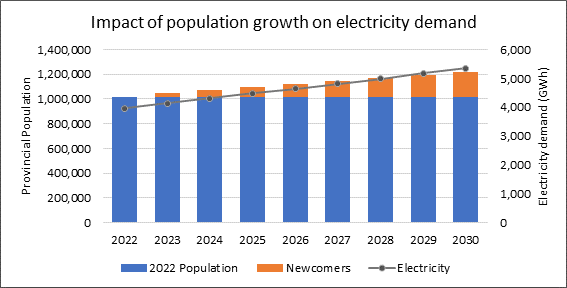Nova Scotia's energy future?
Larry Hughes, PhD
Dalhousie University
13 January 2023
Between now and the end of 2030, an additional 200,000 people will need to call Nova Scotia home if the premier's plan to double the province's population by 2060 is to be achieved.
This means both Chandler Haliburton (Is NS ready for next 500,000 residents? 3 January) and Claudia Chender (Immigrations without housing is reckless, 6 January) are correct, the province will need more infrastructure as its population increases.
But it will not only be housing.
More and wider roads will be needed for the additional traffic created by the vehicles the new Nova Scotians drive.
But as more houses are built and more vehicles are driven, Nova Scotia will also need more energy.
How much more?
Residential energy demand
An additional 200,000 people is a population increase of about 20%.
If we assume 2.5 people per household, this will require 80,000 more residential units.
It also means 80,000 more customers for Nova Scotia Power.
Nova Scotia Power will need to supply each household with electricity for lighting and appliances.
Since the province wants to phase out oil heating, each household will also need electricity for space and hot water heating.
If the new households all use heat pumps and instantaneous hot water heaters, each household's total electrical consumption will be about 9.4 MWh per year.
Consequently, Nova Scotia Power will need to produce an additional 1,176 GWh a year by 2030 to meet the new residential demand.
Vehicle energy demand
In 2019, there were about 585,000 cars and light trucks on the road in the province. That year, the number of vehicles per person in Nova Scotia was slightly over 0.6.
By the end of 2030, if the ratio is unchanged and the premier's population plan still holds, there will be an additional 120,500 vehicles on the road.
Additionally, if trends in the car and light truck market continue in Nova Scotia, we estimate that by 2030 about 30% of the vehicles will be cars and the remaining 70% will be light trucks.
If the fuel consumption of cars and light trucks improves and the average distances driven remain unchanged over the next eight years, greenhouse gases in the transportation sector will increase by about half-a-megatonne.
A rise in transportation emissions will not help the province meet its 2030 or 2050 emissions targets.
However, if the newcomers purchased electric vehicles, transportation emissions will decline but Nova Scotia Power will need to produce an additional 610 GWh by the end 2030.
The impact
Increasing Nova Scotia's population by 200,000 over the next eight years will require more infrastructure and more energy.
The push for electrifying the province will require Nova Scotia Power to increase production by about 10% if electric vehicles are not adopted to over 16% if all newcomers use electric vehicles.

Increased demand for electricity will not be restricted to the residential sector.
Nova Scotia Power will also need to produce electricity for the industrial and commercial enterprises employing the newcomers.
Reliability issues notwithstanding, the province will require more electricity than the Atlantic Loop is intended to supply.
The premier needs to explain how this demand will be met and where the electricity will come from.
He can do it in a new energy strategy.
Published: AllNovaScotia.com, 13 January 2023